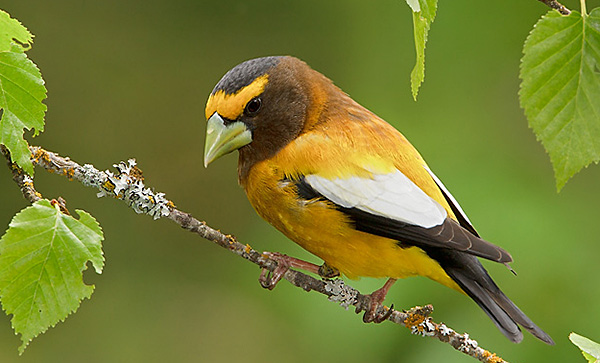The Evening Grosbeak (Hesperiphona vespertina) is a chunky finch with a large, pale beak, and either dark yellow and brown, or gray plumage.
This uncommon species lives in northern and montane forests in Canada, and the western and northern USA. Occasionally, it migrates to woodlands, parks, and backyards well south of its typical range.
If a group of fair-sized, dark yellow and gray finches with black and white wings show up at the feeder, you may have Evening Grosbeaks in the backyard!
On this page
Identification
The Evening Grosbeak is a chunky bird with a big, pale, conical beak. Adult males have dingy brownish-yellow on their back and chest, and bright yellow on their belly and on the shoulder of their wing.
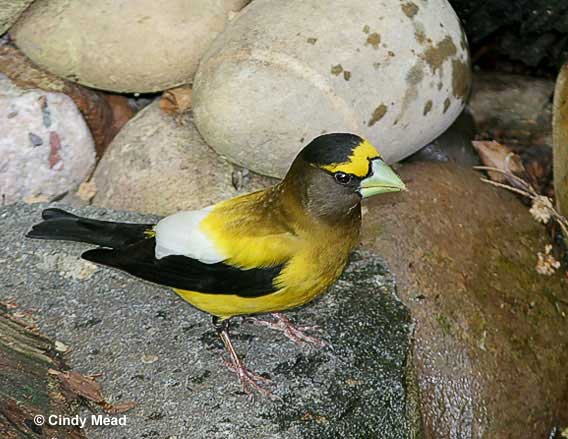
One of the other field marks that stands out is a thick, bright yellow eyebrow that contrasts with their dark gray-brown head. These beautiful birds also have a bright white patch on their long black wings, and a black, forked tail.
Female Evening Grosbeaks look different but still have that same big, pale beak and chunky shape. They have more subtly beautiful plumage that is mostly gray, white on the tip of their tail, and have hints of olive-yellow on their neck and flanks.
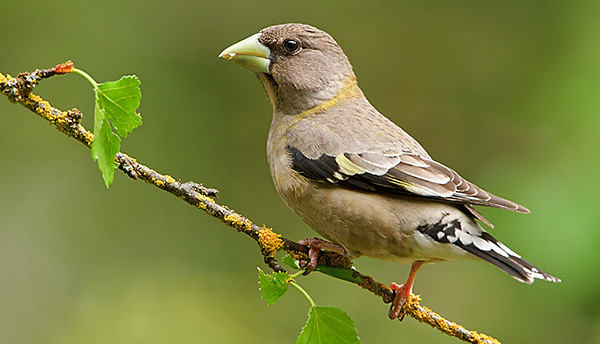
Female Evening Grosbeaks are duller in color
Females also have black and white wings but have a smaller white patch than the male, and have a white undertail. Young males resemble adult females but with a big white patch on their wings.
On average, Evening Grosbeaks are 8 inches long, have a 14-inch wingspan, and weigh 2.1 ounces. We often find these finches when they call, especially in flight. They make a short, buzzy trill, and brief, whistled “peer” calls. The male’s song is a jumbled mix of these calls.
Food
Evening Grosbeaks feed on insects, caterpillars, seeds, and flower buds. They eat lots of beetles, spruce budworms, other insect larvae, and some other insect species.
In general, they eat more invertebrates during the warmer months and have a more seed-based diet during the warmer months.
These pretty finches can also visit feeders at any time of the year but are most frequent during migration and winter. At feeders, they love sunflower seeds and other large seeds.
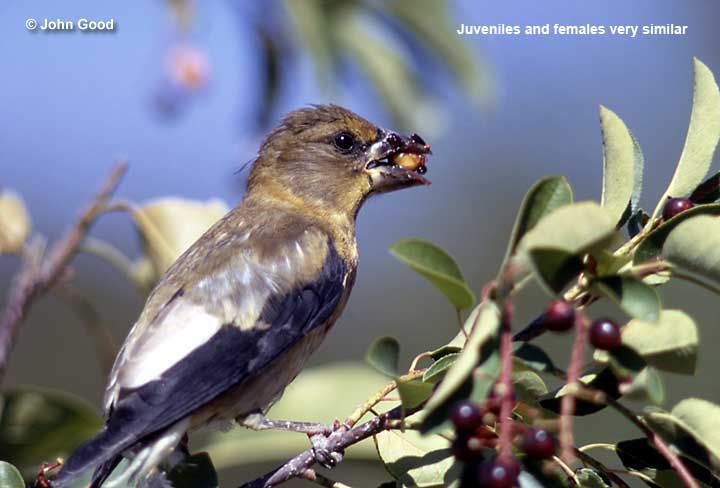
When these beautiful dark yellow finches forage for insects and larvae, they usually perch in the high branches of a tree or on top of a bush and pick food with their beak. However, they can also sally into the air to catch insects in flight. This grosbeak species often feed in conifers but can use other trees too including Alders, maples, and other species.
Evening Grosbeaks usually forage in flocks that wander around in search of good feeding situations. If they find an area with lots of caterpillars, cherries, or seeds, they will stay there until they eat most or all of the food.
Some of the seeds and flower buds they love to feed on include Maple, Elm, Box Elder, Ash, and even the hard cones of Bald Cypress trees.
Nesting and Eggs
Evening Grosbeaks form pairs four weeks before they return to their breeding grounds. Most arrive by mid-May or June and start building their nests right away. To ensure that the babies have plenty of food, they usually nest in places with lots of spruce budworms or other insects.
Females do most of the nest building and can choose a big shrub, sturdy conifer, or other tree for the nesting site. She uses grass, pine needles, twigs, and other plant matter to construct a loose, rather flat, cup nest anywhere from 15 to 70 feet above the ground. The nest is also usually placed at or near the tree trunk.
Female Evening Grosbeaks usually lay three to four pale blue-green eggs with some dark red-brown splotches.
She does all the incubation duties while the male stays near the nest and feeds his mate by regurgitating food directly into her beak.
The eggs hatch after 12 to 14 days, and the babies are fed soft regurgitated insects and eventually mashed-up seeds. The female does most of the feeding, but males help out a little bit. The young birds leave the nest two weeks later and continue to be fed by their parents for one or two more months.
Current Situation
Evening grosbeaks breed in coniferous and mixed forests in Canada, and parts of the western and northern USA. They also live in some montane parts of Mexico. In winter, these finches typically range into the northern and western USA and sometimes migrate as far south as Texas. They can be found in forests, parks and suburban areas with seeding trees, and even backyard feeders.
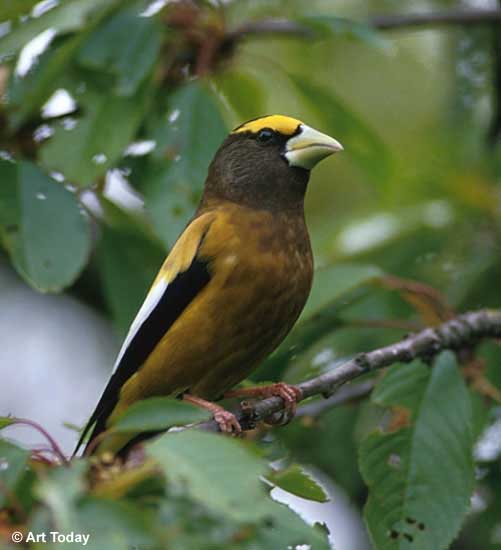
They are listed as Vulnerable in the IUCN Red List.
This species has this conservation assessment because populations have declined by as much as 77% since the 1960s.
Although the reasons for this terrible drop in numbers are uncertain, some of the suspected causes are pesticide spraying to reduce spruce budworms, disease, habitat alteration, and other factors. If this species continues to suffer rapid declines, it could become endangered with extinction.
Facts
- Evening Grosbeaks sometimes eat charcoal, snow, coal, and salt. They may eat these to obtain important minerals or even help eliminate toxins found in unripe seeds and tree buds.
- This species eats big seeds that other smaller birds can’t crack open. Sometimes, Common Redpolls and other small finches feed below flocks of Evening Grosbeaks to eat the open seeds that fall to the ground.
- The Evening Grosbeak is so tied to outbreaks of spruce budworms, their occurrence is often means that an outbreak is about to occur. Before the budworms increase, flocks of this grosbeak often appear.
- Evening grosbeaks are classic irruptive winter finches. In other words, they show up in numbers some winters but, in other years, occur in small numbers or are absent. These fluctuations are related to the availability of food sources on their breeding grounds.
- Historically, this species did not occur in the eastern USA. However, in the early 1900s, they began to increase in numbers and flocks became increasingly common winter birds in the northeastern states. This increase was probably associated with planting more Box Elders and other trees that these finches feed on.
Similar Species
Very few birds resemble the Evening Grosbeak. However, at least two species look a little bit like it.
American Goldfinch
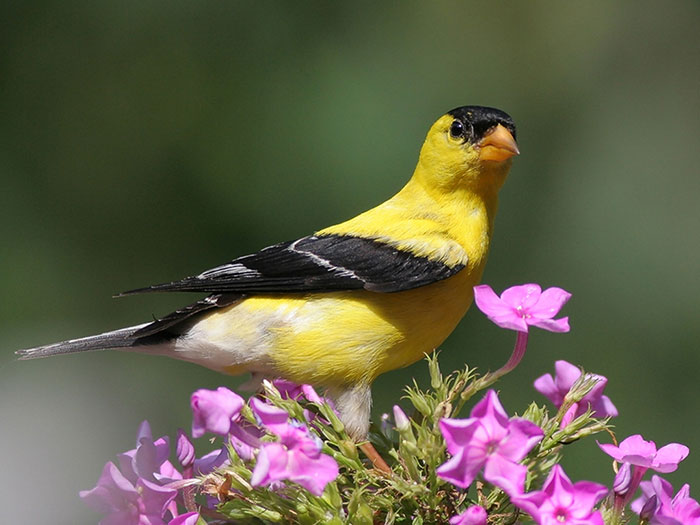
The American Goldfinch has a conical beak and has some of the same colors as the grosbeak. However, the breeding male goldfinch is much brighter yellow and has a black cap.
In winter, instead of having one big white patch in the wing, male and female goldfinches are dingy yellow and pale gray-brown with one or two pale wing bars. In winter, they also have darker, much smaller beaks than the grosbeak.
Pine Grosbeak
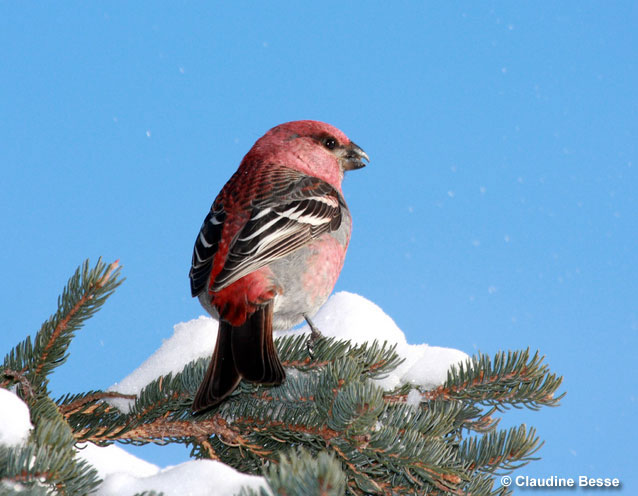
This finch species can also occur in the winter with the Evening Grosbeak, but the male has red in its plumage.
Female Pine Grosbeaks can look a little bit like female Evening Grosbeaks, but they have a smaller, and much stubbier, rounded, dark beak. They also have less white in their wings, and pale markings around their eyes.
Frequently Asked Questions
Where are Evening Grosbeaks most common?
Evening Grosbeaks are most common in montane and northern forests in the western and northern USA, and in Canada.
What does a female Evening Grosbeak look like?
A female Evening Grosbeak is a chunky gray bird with olive-yellow on her neck, a big, conical pale beak, and dark wings with white markings.
How long do grosbeak birds live?
Grosbeak birds can live for as long as 15 years, although many live for five or seven years.
Do Evening Grosbeaks go south in the winter?
Yes, Evening Grosbeaks go south in the winter, usually as far as California, Utah, and northern Pennsylvania. However, every once in a while, they range as far south as southern New Mexico.

